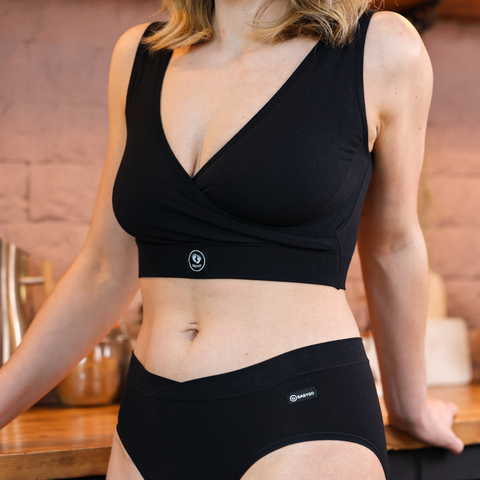You did it! You have introduced your little one into the big wide world and couldn't be happier (there's a 'but' coming). But, although having a baby is one of the endless amazing things the female body can do, you're now ready to focus on YOU, and get back to your life pre-pregnancy!
Contents:
- How does my body change after giving birth?
- Going to the Toilet
- Postpartum Bleeding
- 5 products we know you'll love!
- Let your body do the talking
- Your Questions Answered
You may be thinking ok, how? I'm here to tell you everything you need to know about how to get back that spring in your step, and flourish as a new mum!

How does my body change after giving birth?
From bleeding to piles, urinating to stitches, your body can undergo a hell of a lot during and after birth, particularly in the first 24 hours. Ensure you look after yourself, take things easy, and try to stay as comfortable as possible.
The First 24 Hours
A lot will happen to your body in the first 24 hours after giving birth. It will go through a series of changes as it begins to recover from childbirth.
Immediately after delivery, your uterus will continue to contract, expelling any remaining placental tissue and blood. You may also experience vaginal bleeding, or lochia (we will come back to this).
Your breasts may also start to produce colostrum, the first milk that provides essential nutrients to your baby. You may also feel soreness or discomfort in your perineal area if you had a vaginal delivery or incision site if you had a C-section.
Overall, it's important to rest and take care of yourself during this time as your body adjusts to the changes of postpartum recovery.
The First 6 Weeks
A lot of people say that your postpartum journey will usually last up to 6 weeks, but this is simply utter rubbish!
During this time, the uterus begins to shrink back to its pre-pregnancy size which can cause cramping. Any vaginal bleeding should stop, or settle a lot.
The breasts also change as they produce milk for your baby, and a you may experience soreness, engorgement, or leaking.
Hormonal changes can lead to mood swings, fatigue, and other emotional and physical changes, and you may also get the all clear from your GP or health advisor to start exercising again (if you are feeling up to it of course).
Top Tip!
Remember, it took 9 months to get to get where you are today, so you should allow 9 months (at least) for your postpartum body to recover!
The First 6 Months
Wow, 6 months! I can imagine not only you have changed but your baby too!
Within six months of giving birth, your body will continue to undergo changes as it adapts to the demands of motherhood. The uterus typically returns to its pre-pregnancy size by six weeks, but it can take up to six months for the body to fully recover, and sometimes longer.
You may experience changes in your weight, body composition, and energy levels as you adjust to your new role as a parent. Hormonal changes can still affect mood, sleep, and other bodily functions, however they should have levelled themselves out a lot.
Breastfeeding can also impact the body, with some women experiencing changes in breast size, milk supply, and nipple sensitivity. You should have regained full control of your bladder too!
Top Tip!
Using a nursing pillow whether bottle feeding or breastfeeding can be so beneficial and make feeding time easier!

Going to the Toilet
I feel you mama, after giving birth the thought of peeing can be daunting as you're probably feeling very tender and sore. Make sure you drink plenty of water to dilute your urine and make it a little easier and less painful.
It's common that you may lose control of your bladder which let's face it, makes perfect sense! Try some pelvic floor exercises to help!
Another common thing you may experience is piles. They will usually disappear within a few days however try to eat plenty of fruit and veg, and avoid pushing or straining as it will make them worse.
Why not treat yourself to some postpartum underwear to help you get through?
Postpartum Bleeding
Also known as lochia, postpartum bleeding after giving birth is vaginal bleeding that consists of leftover blood, mucus, and sloughed-off tissue from the lining of the uterus.
It can often be quite heavy and will usually last around 3-6 weeks, so you may want to look at getting some postpartum knickers or absorbent sanitary towels. You can also get c section knickers which you guessed it, are completely c section friendly!
Don't worry, bleeding is completely normal, and is simply your body's way of getting rid of extra blood and tissue that helped grow your baby.

5 products we know you'll love!
Postpartum Knickers
Getting the right underwear can be one of the most simple, yet effective things to do during your postpartum journey. Maternity knickers often have a built in gusset for all those postnatal leaks, and will help to you keep more comfortable.
C section underwear can also be really beneficial as not only can it protect your incision, but apply gentle compression to help your recover. Often made with super soft material, c section pants are designed to give ultimate comfort without irritation, whilst offering support and reducing swelling.

Nursing Bra
Ah, the joys of motherhood! Nothing quite like spraying milk on unsuspecting bystanders. Who needs caffeine when you've got leaky boobs to keep you alert? Just remember to pack some spare clothes and a mop for those unexpected milk showers.
Breast or bottle, a good quality maternity bra is super important! They provide comfort and support, giving easy access for breastfeeding and pumping! Maternity bras also offer handy features such as adjustable straps, easy-to-open nursing clips, and soft, breathable fabrics.
You could also get a nursing sleep bra which care perfect for those crack of dawn feeds. Helping to reduce pain and discomfort, they will mould to your body to accommodate changes in breast size and shape. So ensure you get the best maternity bra for you!

Postpartum Leggings
If you grab the right pair of postnatal leggings after giving birth I can assure you, you won't look back!
Providing gentle support and maximum comfort, postpartum compression leggings can help reduce swelling and discomfort, whilst promoting healing to encourage your body back to it's pre pregnancy shape.
They are also designed with soft, stretchy fabrics that accommodate postpartum changes in body shape, and allow for easy movement and comfort.
Top Tip!
Try a simple workout, gentle jog or light yoga session wearing them, when you get the all clear from your health advisor to start exercising again!

Postpartum Belt
Using a postpartum belt is like having a supportive hug for your belly after giving birth! It helps to hold everything in place, reduce tenderness and swelling, and support your muscles as they heal.
Wearing as much or as little as you like, it provides the best support for your core muscles and lower back, and helps to ease the transition for pre to post birth. Wearing a postpartum belly wrap can also improve posture and mobility.
Have you had a c section? Not to worry! Look at getting a c section recovery belt to help protect your incision, encourage you to heal properly, and give light compression.
Plus, it can give you a little extra confidence when you're getting back into your pre-baby clothes. It's like a secret weapon in your postpartum recovery arsenal!

Nursing Pillow
Using a nursing pillow is like having a personal feeding assistant! Whether you're breastfeeding or bottle feeding they help to position your baby for optimal latch and comfort, whist reducing strain on your arms and back.
For a breastfeeding mama they can help take the extra weight off (especially when baby gets bigger), and for a bottle bottle mama they can be used by anyone who is willing too help with those pesky feeding times.
A pillow can also ensure that baby is upright enough during feeding time to minimise the chances of reflux and being sick.
Not only that, they are perfect to use during tummy time!
Read more about how to use a nursing pillow and all of it's benefits.

Let your body do the talking
Welcome to the postnatal party, where your postpartum belly is the guest of honour and refuses to leave!
Ah, the postpartum belly. It's like a souvenir from your pregnancy, a little something to remember your nine months of glory. Just embrace it and enjoy the extra storage space.
Be kind to yourself and allow yourself time to process what has just happened, after all, you have been growing a baby for the last 9 months!
Now ladies, your postpartum body may feel a bit different - like your boobs are balloons and your tummy is a deflated bouncy castle. But fear not, it's normal! Plus, you get to wear granny panties and all you want and no one can tell you otherwise! Your body will get there and recover just fine, just give it time (and maybe some chocolate).
Your Questions Answered
Will I get my pre-pregnancy body back?
Although we would all love to 'bounce back' after pregnancy, sometimes this just isn't the case and can simply be unrealistic. This isn't to say you won't, it will just take a lot of hard work, time and patience. So don't be too hard on yourself!
How do I know if I have postpartum depression?
It's important to remember postpartum depression is totally normal and actually quite common. Symptoms can include feelings of sadness, anxiety, irritability, and changes in appetite or sleep patterns. If these symptoms persist for more than two weeks, it's important to speak with your healthcare provider.
What is postpartum hemorrhage?
This is excessive bleeding following childbirth, which can occur both during and after delivery. It is a potentially life-threatening condition and can be caused by various factors such as uterine atony, trauma, or coagulation disorders. Immediate medical attention is required to manage this condition.
How long do postpartum night sweats last?
Night sweats can last for a few days to several weeks after childbirth. They are caused by hormonal changes in the body, which trigger excessive sweating, especially at night. Practicing good hygiene and staying hydrated can help manage the symptoms. If night sweats persist for an extended period, consult a healthcare provider.
How soon after giving birth can I have sex?
It's recommended to wait at least 4-6 weeks after delivery and until your doctor has given you the go-ahead. Remember to give your body time to heal and recover from what is has just been through, whether it be a vaginal or c section birth.
When will my periods start again?
There's no given time to guarantee you starting your period again as everyone is different. If you bottle feed or combine bottle and breast, your periods can start as soon as 5-6 weeks. However, if you fully breast feed, they may not start until you start to reduce breast feeding.
How soon can I use tampons after giving birth?
You shouldn't use tampons until your 6 week postnatal check. This is because you may have tears around your vagina and using sanitary products could increase the risk of infection.

Remember, postpartum life can be challenging, but it's also a time for joy, growth, and new beginnings. So don't forget to take care of yourself, both physically and emotionally, and to enjoy those sweet snuggles with your little one!

 Leah Holloway
Leah Holloway













